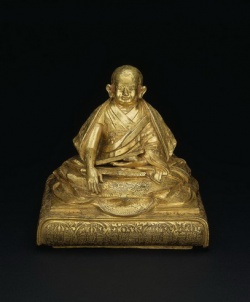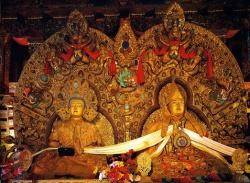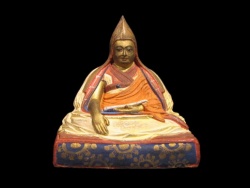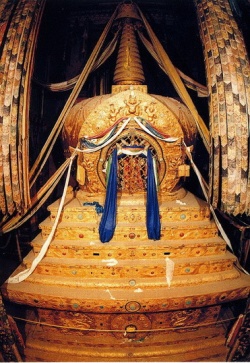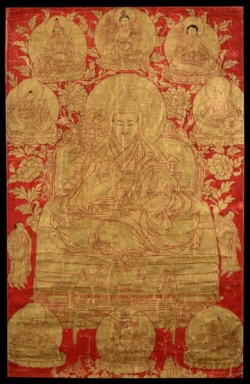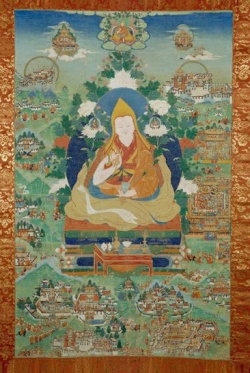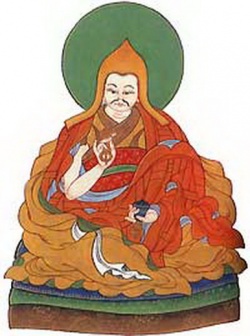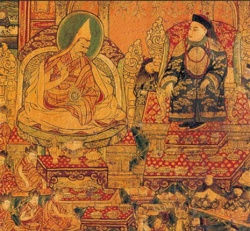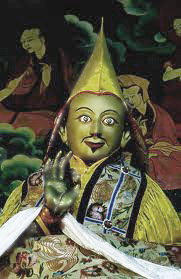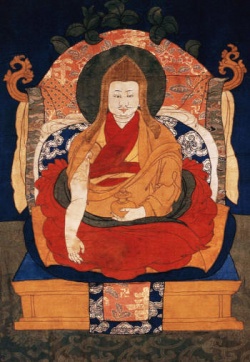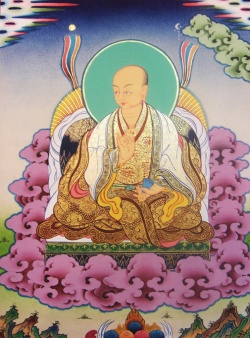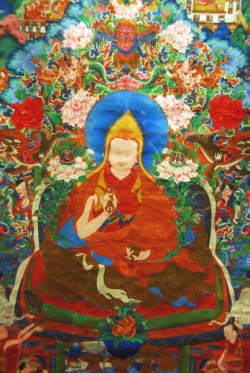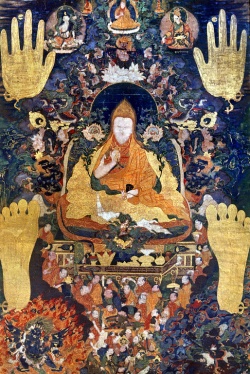The Fifth Dalai Lama Before and After Establishment of dgavldan-pho-brang
Between 1635 and 1642 AD, the dge-lugs-pa sect of Tibetan Buddhism, headed by the fifth Dalai Lama, blo-bzang-rgya-mtsho, allied with Hoshot Gushri Khan to defeat the allies consisting of local forces and religious groups who hated dge-lugs-pa. It marked the end of a long phase of disintegration in Tibet. During this historical period, the Fifth Dalai Lama chose the hour and sized up the situation, exploited his advantages, escaped the disadvantages, cleverly utilized various feudal conflicts amongst his enemies, constantly held the upper hand after every incident, and effectively exerted a major influence on the turn of events. All of this demonstrated hid acute political sense and showed his great political foresight. To some extent, the scholars on Tibetan studies from China have studied the fifth Dalai Lama's historical role and functions during this special period. But due to the shortage of material, the studies were not sufficiently deep. In this article, the author is going to have to make relatively systematical study based on his translation of the book: Auto-biograph of the Fifth Dalai Lama: Yushang.
I.
At the beginning of the seventeen-century, in a political struggle with the karma-bkarv-bryud sect and its supporters (such as ([[[sde-srid-gtsang-pa]])] and some local noblemen) the political and regional forces of dgelugs-pa sect and its confederates were expanded and their previously passive position changed. Then they gradually stepped into the mainstream of local Tibetan government. At the same time, the dge-lugs-pa sect kept a close relationship with some tribes from Mongolia, such as theu-med, khal-kha, orod, groups of aristocrats and chieftains of those tribes, who started to migrate to Tibet. For example, in the second half of 1631, these groups entered Tibet one after another. "Thousands of khal-kha headed by a-ka-tva-chen, over 300 o-rod people, and over 300 thu-med who were escorted by many pilgrims to Qinghai Province and headed by lha-btsun-chung-ba and gu-ru-hong-thevi-ji" Ngag-dhang blo-bzang rgya-mtsho, P 119). These Mongolians came to Tibet for various reasons. Some of them were pilgrims; some sought the establishment of relationships with all sects of Tibetan Buddhism, or contact with the living Buddha. For instance, a-ke-tva-chen from the khal-kha Tribe and mer-rgan-no-yon from o-rod Tribe came to Tibet to petition for the Fifth Dalai Lama to send a mission to Mongolia (Ngagdbang blo-bzang rgya-mtsho, P. 120); some other Mongolians fled to Tibet after losses in battles among the tribes and to seek religious shelter and support so that they could recover and develop. Again, "(1632) the four chieftains from yun-djob of Mongolia moved to tshwavdam. The fundamental reason for this was that legsldan, the King of Cha-gar, defeated their ruler" (Ngagdbang blo-bzang rgya-mtsho, 125).
The coming of Mongolians to Tibet impacted on the two opposing sides in different ways. On the side of dge-lugs-pa, lha-btsun-chung-ba and gu-ru-hong-thevi-ji, those were from Qinghai Province and were great supporters of the dge-lugs-pa sect, retreated to Qinghai Province. Thus the ever-increasing political power of dge-lugs-pa sect was relatively reduced, being menaced and restrained by sde-srid-gtsang-pa and karma-bkav-brgyud sect. Therefore, they were looking for new political supporters. The coming of the Mongolians enabled them to have a choice. On the side of sde-srid-gtsang-pa, in previous studies, they were acknowledged to have attempted to make contact with the Mongolians' tribes while the dge-lugs-pa sect was initiatively looking for the external supporters. However, I hold a different view for this regard. I believe that sde-srid-gtsang-pa's attitude is depressed and passive. At least, such an attitude was evident in the beginning of 1630s. It was because, during that period, although the dge-lugs-pa's political power tended to increase, its military force was still in decline due to the retreat of the thu-med of Qinghai Province and it didn't offer any threat to the rulers. Moreover, during this period, sde-srid-gtsang-pa lifted their efforts to improve their prosperity, cleaned up their internal affairs, strengthened the structure of the regime, initiated contact with those sects and local forces which were hostile to dge-lugs-pa sect in order to strengthen its rule and control the political situation in Tibet. Consequently, the major concern of sde-srid-gtsang-pa was that he did not like any external force to intervene in Tibetan internal affairs, and he remained wary during the coming of Mongolians and their close contact with dge-lugs-pa sect. In the fifth Dalai Lama's biography, it was mentioned several times that a large quantity of Mongolians and their close contact with dge-lugs-pa sect. In the fifth Dalai Lama's biography, it was mentioned several times that a large quantity of Mongolians had swarmed into a place named vdam in north of Tibet, which caused anxiety in sde-srid-gtsadn-pa (Ngag-dbang blo-bzang rgya-mtsho, 116-119). Actually, the entrance of Mongolians into Tibet became a disruptive fact of the Tibetan life. For instance, in 1631, a force of the khal-kha Tribe from Mongolian fled to Zhi Gong. They harried and plundered, and then made conflicted with the Hor Tribe in the northern Tibet. Sde-srid-gtsang-pa designated the Dalai Lama to intercede (Ngag-dbang blobzang rgya-mtsho, P.129).
During this period, the young Fifth Dalai Lama mainly concentrated on study of scriptures and gave sermons. Blo-bzang-chos-kyi rgyal-mtshan, the fourth Panchen Lama, together with his assistants, phyag-mdzod bsod-nams rab-brtan and sde-pa skyi-zhol-pa mtssho-skyes rdo-rje, mastered the political and internal affairs of dge-lugs-pa sect. Nevertheless, although the political situation during this period was much too complex, the fifth Dalai Lama's acute political insight kept him aware of the situation and he adopted strategies to deal with all kinds of complexity. Generally speaking, he tried to build up the relationship of supply and charity ("beneficiary and benefactor" relation), and then gradually strengthened religious contact with Mongolians through missionaries. While he observed their religious tendencies and military capacity, he kept a political arm length from them and did not let the Mongolians interfere in the affaires of dge-lugs-pa or the internal affaires of Tibet. The purpose of such initiatives was to grant whatever was requested, come as soon as called and leave as soon as the hand shake. One example was that, in 1632, the dge-lugs-pa sect experienced feudal conflict over administration and the sect and the conflict situation became worse and management of Jokang Temple. Ill will was spread in the sect and the conflict situation became worse and worse. Some drung-vkhor made the request that they wanted to evict rab-vbyangs-pa chos-dpql, the master of Jokang Temple, through utilizing the force of a-ke-tva-chen, But dgav-ldan-khri-pa said to use the force of sde-srid-gtsang-pa to expel him. However, the Fifth Dalai Lama finally adopted the suggestion of phyagmdzod bsod-namsrab-brtan to solve the conflict by using the fourth Panchen Lama (Ngag-dbang blo-bzang rgya-mtsho, p.125). In addition, the Fifth Dalai Lama always kept an even-handed attitude to those tribes from Mongolia. He participated in their tea chats and religious convocations whenever they invited him, presided over almsgiving and gave lectures. He held the position not to express any opinion when they asked him to lead a mission to Mongolia.
In 1632, chog-thu-thevi-ji from khal-kha of Mongolia was chased in the battle in khal-kha. For the sake of finding a foothold somewhere and a place to settle, he took a fancy to the thu-med tribe in Qinghai Province whose force was gradually declining. He led his subordinates on a march south to Qinghai and defeated the thu-med Tribe. Then he ruled over a wide area surrounding the Qinghai Lake and named himself as Han. In history, he is called "Chog-thu Han" I With regard to his religious belief, there were many kinds of records in different historical materials. Generally, in most of the previous studies, it was acknowledged that Chog-thu was already a believer of karma-bkav-brgyud sect before he settled down in Qinghai. But from book named the Politics and Region History of Amdo it was recorded that he had even invited sde-pa-chos-rje of dge-lugs-pa sect take a mission to Qinghai. It seemed that he followed the dge-lugs-pa sect. In the Biography of the Fifth Dalai Lama, it was said that Chog-thu named himself a believer of bKav-brgyud sect but in fact he followed the Dao Religion of Han, and he was a kind of believer who initiatively tried to proselytize Dao among Buddhism believers (Wu Jun, P.148). Therefore, it was obvious that he was not any permanent believer of any religion, but rather a pragmatic believer following his political needs.
After Chog-thu took up Qinghai, he started to look at Tibet. He joined with Cha-gar legs-ldan-han, who had been defeated in conflict with the Emperor of the Qing dynasty and then he took his force to move toward the west to Qinghai to conspire against Tibet. Legs-ldan-han died due to illness on the way to Qinghai, which resulted in the failure of the alliance attempted by Chog-thu. But he did not give up his ambition of occupying Tibet. In June and July of 1632, his force had reached the northern border of Tibet, and defeated Hor-stod and others. This created a serious situation. But it was worth noting that Chog-thu had yet to allay with sde-srid-gtsang-pa and the karma-bkav-brgyud sect, even through Chog-thu persecuted the dge-lugs-pa sect in Qinghai. In addition, there is evidence that people from the upper class of dge-lugs-pa sect in Tibet still kept in touch with him. The strong force of Chog-thu threatened both sde-srid-gtsang-pa and dge-lugs-pa sect, but the common interest of sde-srid-gtsang-pa and dge-lugs-pa impelled the formerly hostile parties to temporally ally together to resist invasion from outside. Sde-srid-gtsang-pa recruited 130 thousands troop and was ready to resist Chog-thu; meanwhile, he dispatched the fourth Panchen and phyag-mdzod bsod-nams-rab-brtan went to the base of the Mongolian force to mediate. With their efforts concentrated on mediation, the risk of invasion disappeared and the khal-kha Mongolians moved back to their old haunt, and the Tibetan troops disbanded (Wu Jan, P 122).
II.
The threat from sde-srid-gtsang-pa, Chog-thu, and local landlords in Kam, who tended to form a combined force, compelled the Dalai Lama and the upper class of dge-lugs-pa sect to make decision about that whether or not to rely on one Mongolian tribe, and which one to choose, as their external support force.
In the autumn of 1635, ar-sa-langs, son of Chogthu, led over 10 thousand soldiers into northern Tibet. In Damshung (vdam-gzhung), he defeated the descendents of the yun-shab whom were settling down in the northern Tibet after they were chased by or-tu-su-ji-nong several hundred years before. Sde-srid-gtsang-pa was in a blue funk. He immediately changed his attitude toward Mongolians and decided to adopt a strategy of pro-active alliance in order to protect his force and destroy the dge-lugs-pa sect by taking ar-sa-langs. Chos-kyi-dbang-phyug, the living Buddha of karma-bkav-brgyud sect acting as the representative of sde-srid-gtsang-pa, was rushed to Damshuang. He came to an agreement with ar-sa-langs" to decide to allow sa-dam-pa to take up Lhasa, and vbav-rom-pa to occupy rwa-sgrent in order to cut the throat of dge-lugs-pa sect and became the master of karma-pa and vbrug-pa-bkav-brgyud sect" (Wu Jun, P.140).
However, the reaction of dge-lugs-pa sect was completely different from sde-srid-gtsang-pa, and dge-lugs-pa sect's remained calm. During that time, the Dalai Lama was living in seclusion in dge-vphel Monastery close to vbras-spung Monastery. When dar-gdongs mgron-gnyer reported this earthshaking event to bsod-nams-rab-brtan, the Fifth Dalai Lama judged the situation imperturbably. He believed that "the Mongolians would not come to Lhasa in a short time "(Ngag-dbang rgya-mtsho, P.140). And then he remained in seclusion. Eventually, event followed the Fifth Dalai Lama's prediction and ar-sa-langs' troop came to Lhasa in the beginning of 1636.
It is shown in some sources that during this period, dge-lugs-pa had contacted ar-sa-langs several times, and to some extent they reached agreement. In the Biography of the Fifth Dalai Lama, it was mentioned the at in June, July, and October of 1636, "we (dge-lugs-pa) had established a deep relationship with Mongolians through exchange of envoys "(Ngag-dbang rgya-mtsho, P 141). Such initiative, together with Gushri Khan's persuasion when he encountered ar-sa-langs in 1635 on the upper stream of Tong Tian River, enabled ar-sa-langs to gradually change his attitude toward dge-lugs-pa. Until October, ar-sa-langs sarted to change his attitude to chos-kyi-dbang-phyug of karma-bkav-brgyud. He became very cold and the previous agreement became a useless paper. The red hat rab-vbyang-pa's plan was lost and it was just like a sudden raw blow (Ngag-dbang blo-bzang rgya-mtsho, P.141), and the situation became much more favorable for dge-llugs-pa.
At the end of 1635, ar-sa-langs and the fifth Dalai Lama saw a dramatic change. In the new year of 1636, ar-sa-langs wrote a letter to the fifth Dalai Lama proposing a meeting. During that time, he actually commanded that anybody was forbidden to kowtow while encountering the fifth Dalai Lama. But when met Dalai Lama at the second day, he did salute and kowtow, and he even asked Dalai Lama to give blessing. When thabs-nang-o-rgyan-slob-dpon lha-btsun questioned him, he answered: "I have changed my mind" (Ngag-dbang blo-bzang rgya-mtsho, P 142). Such behavior demonstrated the point that ar-sa-langs and his son have no permanent belief with regard to religion. In addition, it also shows that ar-sa-langs had already smelled out the strength of dge-lugs-pa and how to turn it to his advantage. Therefore, political and economic interests impelled him to turn to dge-lugs-pa.
Sde-srid-gtsang-pa himself recognized his force was not strong enough against the Mongolian force. He designated karma-pa and his disciple, stag-lung-zhabs-drung and the fifth Dalai Lama to negotiate with ar-sa-langs in order to reach an agreement. ar-sa-langs was sick in bed and he realized there were no advantage for him in fighting. With the intervention of some people, such as the fifth Dalai Lama, he finally gave up his plan to attack gtsang area. In June of 1636, he made a ceasefire agreement with sde-srid-gtsang-pa.
However, some living Buddha from the red hat sect of karma-bkav-brgyud, such as chos-kyi dbang-phyug and lhun-po thevi-ji, were not satisfied because of the retreat of the Mongolians to the background. They sent people to Chog-thu in Qinghai to criticize ar-sa-langs and his son. As a result, Chog-thu's ambition state progressed from the struggle between dge-lugs-pa and sde-srid-gtsang-pa to a new state.
III.
As early as the beginning of Chog-thu's force approaching the border of Tibet, the upper group of dge-lugs-pa, lead by the Fifth Dalai Lama, had sought help from o-rod Gushri Khan of the Mongolians for protection. In the spring of 1635, bsod-nams-rab-brtan and skyi-zhol-sde-pa sent envoys to o-rod tribe via Qinghai and asked Gushri Khan to provide military assistance. But Gushri Khan at that time was experiencing internal instability and external aggression of. For the sake of survival and economic development, he planned to send his forces to seek development by aggression against his neighbors. However, the request for support fro mDge-lugs-pa offered a excellent opportunity and enabled him to move on Qinghai. In order to have a field survey of Qinghai and Tibet and have face-to-face negotiations with the upper class of dge-lugs-pa, Gushri Khan and ba-tur-hong-tari-ji, with a light pack, headed to Tibet via Qinghai.
In the autumn of 1636, Gushri Khan arrived in Lhasa. Some scholars believe that, after discussion in Lhasa, Gushri Khan and his force were sent to Qinghai to defeat Chog-thu, and Baili (don-ydo-rje) in Kam, and finaly destroyed the local regime of sde-srid-gtsang-pa. Giuseppe Tucci, and Italian scholar, in his book "The Middle Age History of Tibet" was the first person to claim that (Giuseppe Tucci, P.114). From then ,scholars have held that position. However, I think the situation, when Gushri Khan arrived in Lhasa, was quite different from the state in 1635, when dge-lugs-pa sought succor. In fact, during this time, dge-lugs-pa's enquiry was not as urgent as before. Along with the death of ar-sa-langs and a declining risk from Chog-thu, the common interest dulled the conflict between dge-lugs-pa and sde-srid-gtsang-ps, and their conflict changed from overt to covert. During the same period, the internal feuding of dge-lugs-pa resulted in different opinions, in which one party wanted to solve the problem by fighting, but the other sought a peaceful socution. However, the Fifth Dalai Lama had a clear concept of the influence and position of Dge-lugs-pa in Tibet. He stuck to the position of dge-lugs-pa on the defeat the local regime of Sde-srid-gtsang-pa. He recognized that it was a long-term strategic objective to ensure the rule of dge-lugs-pa in Tibet. When people suggested that "Please Zhags-drung-rin-po-che (the fifth Dalai Lama), you should follow the lead of vphagspa's story of acting as the anba in Han, when bsodnams-rab-brtan becomes the leader of Tibet", he will agree that gling-smad-zhags-drung's words that "in the current situation of Tibet, the power of the western Tibet could reach to the heaven. How come that bsod-nams-rab-brtan could become the leader of Tibet." He believed that it was just a jape (Giuseppe Tucci, p.138) Therefore, he was scrupulous in drawing support from Gushri Khan's force to solve the issue of Tibet. He just wanted to use the influence of Gushri-Khan to relieve the pressure on the borders, such as from Chog-thu, rather than directly allying with Gushri Khan. He believed that "Currently some people in dge-lugs-pa and the Mongolian force expect to have a hig ferment. However, if so, it will bring no benefits from Tsong-kha-pa because of his sermon. The local chieftains from Lhasa had pinned their hopes on dgav-ldan-pho-brang's regime, but if they followed the doctrine of the Buddha to look before they leap, it could be better "(Giuseppe Tucci, p.149). While getting in contact with Gushri-Khan, it was most important to take this opportunity to consolidate and develop the relationship of beneficiary and benefactor between Tibet and the o-rod tribe of Mongolians which was set up during the period of the third Dalai Lama. By taking the advantages of Gushri Khan's force to diminish the hostile forces around the border of Tibet, it was politically important to establish a strong counterforce to sde-srid-gtsang-pa. The plan was that Gushri Khan would attack sde-srid-gtsang-pa after he had defeated Chog-thu and Baili (don-yod rdo-rje). Therefore, I believe that, when both parties discussed this issue, they reached a common agreement on defeating Chog-thu and Baili. However, the consequential result was the fact that Gushri Khan afterwards actually defeated Sde-srid-gtsang-pa.
It was particularly clear that the Fifth Dalai Lama was than scrupulous on the defeat of Sde-srid-gtsang-pa by using Gushri Khan's force. One of the reasons was mentioned above. But the other important reason was that he still believed that Sde-srid-gtsang-pa was an actual local headman who was officially controlled by the central regime of the Ming Dynasty. During that period, the Ming Dynasty was between the hammer and the block, but the overall position of the central regime in exercising complete control over the Tibetan local government was the same as usual. As the religion leader of the Dge-lugs-pa, the Dalai Lama, even through he was quite vague about the downfall of Ming Dynasty, was still expect to maintain the same relationship as it before with the central regime after Dge-lugs-pa achieved control over Tibet. For example, in June of 1636, it was just several months after Gushri Khan entered Tibet. He described some nature phenomenon as "signs of the golden bridge which will be established soon between Tibet and Han". 2 Because of this reason and together with the above mentioned several reasons, the Dalai Lama had justifiable suspicions regarding Gushri Khan.
One more point also needs to be mentioned here. During this period, the rise of the upper class of the Dge-lugs-pa. Regarding the source of the information dissipated about the Manchu's powerful force might have originated from Gushri Khan. According to historical records, Gushri Khan had already started to sent envoys to the Manchu ruler during this period. With his close contact with royal members, he was aware of potential developments and possible aftereffects. By controlling the Qinghai-Tibetan plateau, he was able to spread information to the upper class of Dge-lugs-pa. Such information was about the rise of the Manchu, evoking the interest of the Fourth Panchen Lama who was the one of the decision madders in Dge-lugs-pa. While Gushri-Khan was attacking baili the fourth Ban Chan Lama had already suggested to se-chen-chos-rje: "The King jur-child's force is powerful, please go to see if he could give us assistance" (Ngag-dbang blo-bzang rgya-mtsho, P.137). With the consultation of the Fifthe Dalai Lama and the Fourth Panchen Lama, it was decided that I-la-gug-sam huthugthu and se-chen-chos-rfe (Kai Qing Zhuo Er Ji written in Chinese historical materials) were sent to Shengjing to get in touch with Manchu rulers. During this period, Sde-srid-gtsang-pa got on well with Manchu rulers. While I-la-gug-san huthugthu went to Shengjing, he also brought word to the Emperor. In addition, the living Buddha of the red hat system of Karma-bkav-brgud sect sent letters to the Emperor through envoys. This revealed that the power of Manchu rulers widely attracted the attention of the various local forces and religion sects of Tibet, even through they still did not predict that the Manchu rulers would enter the middle territory of Chinese in one day of the future.
IV.
After Gushri khan went back to Orod, based on the agreement with Dge-lugs-pa, he led hoshot tribals force in the autumn of 1636 into Qinghai from Xinjiang, assisting by i-la-gug-sanhuthugthu. In early 1637, Gushri khan led ten thousands solders to defeat thirty thousand solders of Chog-thu in the region of now Tibetan Autonomous Prefecture of Haibei of Qinghai, and also killed Chog-thu Ngag-dbang blo-bzang rgya-mtsho, P. 167-P168). One year later, he gradually moved ho-shod tribe to Qinghai in order to control it.
The collapse of Chog-thu and the occupation of Qinghai by Gushri khan terrified Sde-srid-gtsang-pa and also Don-yod rdo-rfe in Kam, who was another enemy of Dge-lugs-pa and was living in Qing Hai on the flank of Tibet. Don-ylod-rdo-rfe, in part, followed the Bon religion. He occupied most areas of Kam, such as Derge (sde-dge), Chamdo (Chab-mdo), and Riwoche. He was used to persecuting the shaman of Dge-lugs-pa. He blockaded the roads from Kam to Tibet, and "intersected the golden bridge to Tibet" to stop those sent to collect the tea levy for sa-dam (Li Jiang of Yunan) by Dge-lugs-pa. He blockaded the roads from Kam to Tibet, and "intersected the golden bridge to Tibet" to stop those sent to collect the tea levy for sa-dam (Li Jiang of Yuang) by Dge-lugs-pa; gifts from dignitaries, monks and almsgivers from Yunna, Kam and other areas, could not be sent to Dge-lugs-pa (Ngag-dbang rgya-mtsho, p.171). The purpose was to try to threaten Dge-lugs-pa in order to ensure the Mongolians could not enter into Kam. The Fifth Dalai Lama hated Don-yod rdo-rje and considered "him guilty beyond forgiving", and "he was one of persons ought to be wiped off" (Ngag-dbang rgya-mtsho, P.171). With Gushri khan's political success, Gushri khan foresaw that the nest to be killed was himself. Thereupon, he tried hard to get in touch with Sde-srid-gtsang-pa, he said "because dgav-ldan-khri-pa did not guarantee the Mongolians will not attack Kam, I will lead my force to the middle of Tibet. The copper statue, named jo-bo-rin-po-che was the cause of conflict. It should have been thrown into the river. After destroying the three biggest monasteries, se-ra, vbras-spung, and dgav-ldan, it is necessary to build up a tomb pagoda on the ruins. Sde-srid-gtsang-pa should get along with me, and both of us should administer both Buddhism believer and Bon believer in Tibet and Kam" (Ngag-dbang rgya-mtsho, P.171). From some sources, it was revealed that this letter was intercepted by some person from Dge-lugs-pa and conveyed to Gushri khan. However, in the 'Autobiography of the Fifth Dalai Lama", it was mentioned that Sde-srid-gtsang-pa had received this letter and replied through Za La Jian who was a businessman (Ngagdbang blo-bzang rgya-mtsho, P.171). Whatever happened, don-yod-rdo-rje so that further defeat of Be-ri could become a reality. In 1639, Gushri khan led his force to attack and seize Kam. After a year's fight, he finally defeated Be-ri and occupied most territory of Be-ri, then Be-ri was executed.
After Gushri khan destroyed Be-ri, he immediately sent dge-gnyen-don-grub to report the victory, and also asked se-chen-ou ba and a big group of Mongolians to pay respect to the Dalai Lama. During the Grand Summons Ceremony (smon-lam chen-po) in the first month of Lunar year of 1640, Dalai Lama was very pleased after he heard of Gushri khan's victory, and he wrote an epigraphy an epigraphy on a silk scarf to thank the Buddha.
Gushri khan was ready to go to the battle with Beri at the end of the summer in 1639, he sent shri-ti-pa-thur, his house boy, to bring his letter to Dalai Lama. In his letter, he mentioned his strategies for attacking Sde-srid-gtsang-pa after he defeated Be-ri. This letter had caused a big argument between the war party and peace party in the dge-lugs-pa. The Fifth Dalai Lama in the peace party suggested that Gushri khan should come back to Qinghai after he defeated Be-ri but not go for attacking Sde-srid-gtsang-pa. He had three reasons for this. Firstly, Sde-srid-gtsang-pa would recognize he was in trouble after Gushri khan Be-ri. Therefore, he would change his attitude toward Dge-lupgs-pa. To some extent, he would strongly control persecution on Dge-lugs-pa. In fact, during this period, he had even donated his several manors to Dra-shilhunpo monastery to please the Fourth Panchen Lama. The Fifth Dalai Lama thought that Sde-srid-gtsang-pa, during this period, would not "do things wrong, and be not benefit as well". "Currently Sde-srid-gtsang-pa had learnt self-respect and self-love, and he became interested in the doctrines of the dge-lugs-pa's monasteries" (Ngag-dbang blo-bzang rgya-mtsmo, P.171, 167). Dalai Lama thought that his group would lose the people's trust and be sneered at if they were seen to be actively promoting a war. Secondly, Dalai Lama was quite contented with the situation of dge-lugs-pa at this stage, but he was worried that the con-sequences of the war might bring disadvantages to Dgav-lugs-pa. He believed that "Dge-lugs-pa's authority and the force of Dge-ldan-pho-brang are already enough. If not satisfied at this stage, past unresolved events would be brought up again, and we would face the same difficulties as before "(Ngag-dbang blo-bzang rgya-mtsho, P. 167-168). Thirdly, (this was also the main point of Dalai Lama) he thought that Sde-srid-gtsang-pa's force was strong. Although adopting the force of Gushri khan, it was still hard to defeat Sde-srid-gtsang-pa. This concern of Dalai Lama was clearly manifested when he persuaded Bsod-nams-rab-brtan. He said: "Once a hostile state was created with Sde-srid-gtsang-pa, … it was clear that there would be no one sitting on the throne of Buddhism. "(Ngag-dbang blo-bzang rgya-mtsho, P. 167-168).
On the contrary, the war party led by Bsod-nams-rab-brtan was exited with the news that Gushri khan would come to attack Sde-srid-gtsang-pa. When they discussed this issue with the Fifth Dalai Lama, Bsodnams-rab-brtan decisively proposed "Doing it by following the instruction of King Khan" (Ngag-dbang blo-bzang rgya-mtsho, P. 167-168). After the Fifth Dalai Lama repeatedly explained his disagreement with and the disadvantages of Gushri khan attacking Sde-srid-gtsang-pa, Bsod-nams-rab-brtan seemed to follow the words, but in fact he still pro-war. While he said farewell to the envoy of Gushri khan in the Norobulingka, Bsod-nams-rab-brtan repeatedly urged the envoy in front of the fifth Dalai Lama: "We must totally destroy Be-ri. After the King Khan went back to Qinghai, he would send two princesses to set up cordial relationship. In Tibet, he ought not to have any war." (Ngag-dbang blo-bzang rgya-mtsho, P. 167-168). In the second day, Bsod-nams-rab-brtan pretended to give the gifts to dge-gnyen-don-gsar to plot with dge-gnyen-don-grub. With great self-assertion, he gave a letter the Gushri khan and asked him to defeat Sde-srid-gtsang-pa. When the Fifth Dalai Lama heard this, he could only expressed his regret and said : "I never thought that the peaceful fluting had become the sound of an arrow (War)." (Ngag-dbang blo-bzang rgya-mtsho, P. 167-168).
With the acquiescence of dge-lugs-pa and also the cooperation, Gushri khan immediately acted. Gushri khan was a cannily person who was a strategically sharp eyes and could also flexibly use tactic. Before he initiated the attack, he diffused the news everywhere, and pretended to come back to Qinghai from Markam (vbar-khams) in order to delude Sde-srid-gtsang-pa. Nevertheless, his plan to attack the middle of Tibet had also been disseminated. Immediately, the rumor spread everywhere in the middle of Tibet, and the Fifth Dalai Lama found out that Bsod-nams-rab-brtan had asded Gushri khan to dispatch troops. Bsod-nams-rab-brtan had to show his cards and explained: "It will be poor strategy if we say an thing to Sde-srid-gtsang-pa or his subordinates, and the only thing to do is to confuse him. If we do not take the opportunity to relieve Sde-sri-gtsang-pa from his beliefs by using Gushri khan, there will be no more opportunity. Therefore, while sending dge-gnyen-don-grub as the envoy, I had already proposed the petition by asking Gushri khan to defeat Sde-srid-gtsang-pa." (Ngag-dbang blo-bzang rgya-mtsho, P. 174). However, the Fifth Dalai Lama still wanted to persuade Gushri khan to retreat to Qing Hai. Then he put pressure on Bsod-nams-rab-brtan and said: "Such action is obviously inappropriate. If you persuaded Gushri khan to go back form vdam, it could be successful. If you feel too embarrassed to pursue him because of your previous words, I would like to go to vdam to see him and convince him sincerely and passionately. And the consequences could bring great benefits and credit to us. (Ngag-dbang blo-bzng rgya-mtsho, P. 174). Therefore, the two sides stuck to their own views and they all refused to budge. Finally, they had to make the decision through augury in front of the retreat angel of dpal-ldan-lha-mo-dmag-zor-ma. However, from the augury, it was asked to come, but it would result in a bad consequence in the long run (Ngag-dbang blo-bzang rgya-mtsho, P. 174). Bsod-nams-rab-brtan insistently said: "Temporary benefit was enough. And everybody will died eventually" (Ngag-dbang blo-bzang rgya-mtsho, P. 174). With the acquiescence of Bsod-nams-rab-brtan, the Fifth Dalai Lama finally kept silent.
At the beginning of preparing to attack Sde-srid-gtsang-pa, for the sake of protecting the Fifth Dalai Lama, Gushri khan had even invited Dalai Lama twice to Mongolia under the name of furthering Buddhism, but it did not happen because of the impediment created by Bsod-nams-rab-brtan and Sde-srid-gtsang-pa. Gushri khan was marching to west Tibet. To protect the fourth Panchen Lama, he wrote to the Fifth Dalai Lama, if the older ranee could come to Shigatse for a pilgrimage. Gushri khan asked if the Fifth Dalai Lama sent dkav-bcu-ye-shes-rgya-mtsho to greet the fourth Panchen Lama. All these activities of the Gushri khan and Dge-lugs-pa attracted the high vigilance of Sde-srid-gtsang-pa. When Panchen Lama journeyed to rin-spanges, the monks of stag-lung monastery had already reported to sde-srid-gtsang-pa that Gushri khan did not come back to Qing Hai. Therefore the Fourth Panchen Lama had to temporally stay in mkhar-sding.
After Gushri khan started to head to west Tibet, the war party, lead by Bsod-nams-rab-brtan in Dgelugs-pa, had initiated support and cooperation. When Gushri khan arrived vdam area, Bsod-nams-rab-brtan rushed to cantonment to discuss with Gushri khan about war strategy. In order to relieve Gushri khan's worry, Bsod-nams-rab-brtan brought Gushri khan's two concubines to Lhasa, and also left dar-dong-nas as the usher for Gushri khan in order to head to the west Tibet. He also sent se-bu-rab-brtan as the logistic officer in order to provide supplies for the Mongolian army. In addition, he mobilized many monks of the Dge-lugs-pa to travel all over Tibet to try to get in touch with the local chieftains and monks in all monasteries. They organized the local chieftains who inclined to Sde-srid-gtsang-pa. While the war was critical, bsod-nams-rab-brtan himself organized the young monks of vbrasspung and se-ra monastery and also the force of the manors to attzck dung-dkar-rdzong, and then impel-bde-chen-rdzong, nevu-rdzong.
Opposing the war party, the Fifth Dalai Lama had been always at eh passive side of cooperation since the war started. He was waiting to make decisions based on the developments of the war. When the war got into a critical stage and the Dge-lugs-pa had no way out; he changed his original intention and decisively cooperated with Gushri khan to defeat Sde-srid-gtsang-pa mustered all his forces to defend against the Mongolian force. The provisions of the Mongolian force were in difficulty. By facing with the situation, bsod-nams-rab-brtan, always a tough man, was biting his nails. He had to asked the Fifth Dalai Lama to act as intermediary. He said: " I thought the enemy would immediately respond to the news that Gushri khan was coming and submit to him. Now the army has taken heavy losses. It was unexpected. Therefore, at present, you could be the right person to go to west Tibet to be the peace-maker " (Ngag-dbang blo-bzang rgya-mtsho, P. 175-176)". Then he calmly analyzed the situation. He recognized that "Now people have already witnessed Dge-ldan-pho-brang also sent dar-gdongs-pa to induce the Mongolians to head to the west Tibet. Therefore, how can I be the intermediary? The officers of Sde-srid-gtsang-pa are very experienced and astute. They would retaliate after the Mongolian solders left, even though now they temporarily accept the reconciliation (Ngag-dbang blo-bzang rgya-mtsho, P175-176)." Finally, the Fifth Dalai Lama gave up any intention of reconciliation with Sde-srid-gtsang-pa, and decided to keep on fighting. He encouraged Bsod-nams-rab-brtan and said: "While Gushri khan wrote a letter to say he would head for west Tibet should be made, and we should not step on two boats at the same time. We should try our best according to the rules of both religion and secular life. No matter whether success or failure, we will never accept to live under the control of Sde-srid-gtsang-pa. In this point, there is no doubt." (Ngag-dbang-blo-bzng rgya-mtsho, P. 175-176). The affirmative and decisive attitude of the Fifth Dalai Lama encouraged bsod-nams-rab-brtan to continue to prosecute the war, which finally resulted in the victory of dge-lugs-pa.
Sde-srid-gtsang-pa suffered repeated defeat by the strong attack of the Gushri khan's Mogonlian force and the Dge-lugs-pa. He lost many areas where he had no choice but to seek reconciliation. He had written several times to the Fourth Panchen Lama, stag-lung-zhabs-drung, and rgyal-tshab-drung-pa. He petitioned them to be the intermediary. During that time, he had recognized the Fifth Dalai Lama as the "prime criminal and demon", and he doesn't think the Fifth Dalai Lama was the right person to be intermediary. Without any choice, Sde-srid-gtsang-pa had to accept the conditions from Gushri khan under the intermediation of the Fourth Ban Chan Lama and confess his guilt in front of Gushri khan. On hearing of the surrender of Sde-srid-gtsang-pa, the Fifth Dalai Lama and Gushri khan congratulated each other. Now they had to consider how to treat Sde-srid-gtsang-pa. The Fifth Dalai Lama, considering how to stabilie the situation of the Tibet, approached an agreement with Gushri khan, and decided to give unto sime manors to Sde-srid-gtsang-pa as his pension. However, some local aristocrats and persons from the Karma-bkav-brgud sect who were espousing Sde-srid-gtsang-pa launched repeated rebellions in west Tibet, and tried to rescue Sde-srid-gtsang-pa. In order to root out the rebels, Gushri khan had to execute Sde-srid-gtsang-pa.
At the beginning of 1642, the situation in Tibet started to become stable. While the Fifth Dalai Lama was thinking about the future of Tibet, Gushri khan had faced the problems arising from the death of Sde-srid-gtsang-pa. In March of 1642, Gushri khan sent dargdongs-mgron-gnyer to greet the Fifth Dalai Lama at the Dechen. In Shigatse, "The King khan announced he would donate 130000 households to me, which includes those in Shigatse" (Ngag-dbang blo-bzang rgya-mtsho, P 185). Actually, there were no 130000 households, and it just showed Gushri khan's respects to the Fifth Dalai Lama. His intention was actually his ambition to realize the legality of his control of Tibet through his cooperation with Dge-lugs-pa. The Fifth Dalai Lama. His intention was actually his ambition to realize the legality of his control of Tibet through his ambition to realize the legality of his control of Tibet through his cooperation with Dge-lugs-pa. The Fifth Dalai Lama considered that the situation was just stabilized, and he believed that it was hasrd for Dge-lugs-pa to only rely on itself to control the situation of Tibet. "The current political situation of Tibet could be fixed if a leader was in position. The disintegration of the sa-skya, bkav-brgyad, snying-ma, and other sects could be reversed" (Ngag-bdang blo-bzang rgya-mtsho, P. 185). Therefore, the Fifth Dalai Lama at once responded: "Based on the goodwill of King khan, there is no evidence to show his intention of temporarily eliminating the impediments in order to bring benefits to his future. Therefore, it is a deep favor, and we hardly repay him in a life time" (Ngag-dbang blo-bzng rgya-mtsho, P. 185). Thereof, Tibet has again escaped from falling into risk and turmoil. And Tibetan society therefore steps onto a relative stabilized developmental period.
Notes:
1. Regard to the name of "Chong-ghu-han", see Fan Baoliang, Studies on the Relationship of Mongolia and Tibet, Qinghai People's Publishing House, Aug. 1992, 1st Edition, pp. 171-172, 173-174.
2. The Fifth Dalai Lama, the Record of the King and Ministers of Tibet, translated by Guo Heqin, Beijing, Nationalities' Publishing House, 1983, P.177.
3. Ngag-dbang-blo-bzang-rgya-mtso, Biography of the Fifth Dalai Lama, translated by Chen Qingying, Ma Lianlong, Ma Lin, Beijing, China Tibetology Publishing House, Dec, 1997.
4. Vbri gung pa dkon mchog bstan pa rab rgyas, the History of Anmdo Politics and Religion, translated by Wu Jun, Gansu, Nationalities' Publishing House, 1989.
5. Giuseppi Tucci, the Mediaeval History of Tibet, Translated by Li Youyi and Deng Ruiling, Ethnology and Anthropology Institute of the Chinese Academy of Social Sciences.
